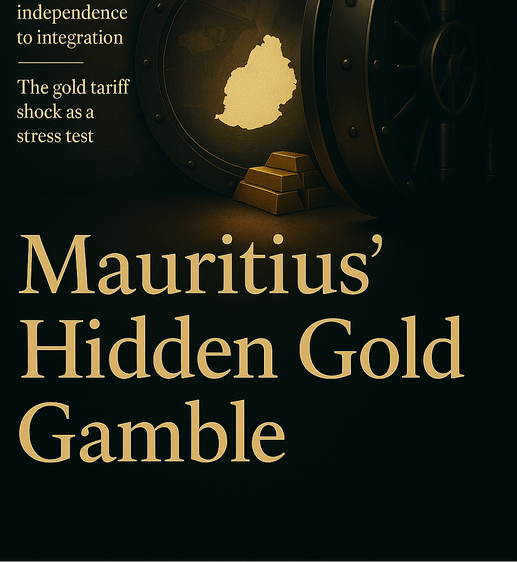Mauritius’s Gold Reserves: A Gilded Illusion?
In February 2025, the Bank of Mauritius quietly reported that the country’s gold reserves had reached 12.42 tonnes, valued at USD 1.132 billion the highest since records began in 1976. On paper, gold now accounts for roughly 16 per cent of the nation’s gross official reserves, which stand at USD 7.06 billion, providing 10.8 months of import cover. In a region where foreign currency scarcity has sparked currency collapses and IMF bailouts, these figures project an image of stability. Yet the numbers conceal more than they reveal.
The opacity of ownership
Nowhere in the Bank’s audited accounts or monthly statements even under the transparency provisions of the Bank of Mauritius Act (2004) is there a breakdown between gold physically stored in the country and gold leased out through international markets. This is not a trivial omission. Under the accounting rules used by most central banks, leased gold still counts as a reserve asset, even though it may be thousands of kilometres away in a London Bullion Market Association (LBMA) vault, held by a counterparty that can refuse or delay return in a crisis.
For a small island state dependent on imports for over 70 per cent of its food and virtually all its fuel, the distinction is critical. In a liquidity crunch whether from a currency slide, a sanctions regime, or a sudden spike in gold prices leased gold cannot be sold without first being bought back, often at unfavourable terms. The apparent cushion may prove illusory.
From independence to integration
Mauritius’s reserve strategy has always been shaped by external forces. At independence in 1968, foreign exchange controls and a sterling peg kept reserves modest but stable. The 1970s oil shocks forced the Bank to diversify into U.S. dollars and, later, gold. By the mid-1980s, under IMF structural adjustment, Mauritius embraced a more open capital account, linking its reserves to global commodity and currency markets. Gold, however, remained a symbolic rather than strategic asset a hedge against volatility, not an active policy tool.
The late 1990s brought another shift. As the offshore financial sector expanded, the Bank began to mirror the strategies of larger, globally integrated central banks. This included participation in gold leasing markets, a practice designed to earn interest on idle bullion but one that quietly transferred physical control abroad. By the early 2000s, Mauritius’s gold was largely custodied in foreign vaults a fact never officially acknowledged but evident from trade and banking disclosures.
The mechanics and the risks of gold leasing
In theory, gold leasing is straightforward. The central bank lends gold to a bullion bank or other market participant, receiving a lease rate (usually well below 1 per cent). The borrower sells the gold into the market, using the proceeds for other investments, and later repurchases the gold to return to the lender. The lender in this case, the Bank of Mauritius still books the gold as part of reserves, valuing it at market price.
In practice, the risks are asymmetric. If the gold price spikes as it did during the 2008 financial crisis and again in the 2020 pandemic the borrower may struggle to buy back at higher prices, risking default. The lender’s recourse is contractual, not physical. In a systemic crisis, recovery can take months or years, during which time the gold is unavailable. For large economies, this is a liquidity inconvenience; for a small import-dependent island, it can be a sovereign risk event.
The gold tariff shock as a stress test
The recent U.S. decision to impose tariffs on imported 1 kg and 100-ounce gold bars, briefly sending futures to record highs, offers a warning. Although the White House moved to reverse the measure after market backlash, the incident exposed how quickly trade restrictions can destabilise bullion markets. For Mauritius, any sustained spike in gold prices could complicate the repurchase of leased gold especially if currency depreciation magnifies the local-currency cost.
In such a scenario, the rupee could come under speculative attack, forcing the Bank to deploy foreign currency reserves more aggressively. The political consequences would be immediate: higher import costs, rising inflation, and pressure on subsidies. In a country where bread and fuel prices have triggered street protests in living memory, the stability of gold reserves is not an abstract technicality but a potential political flashpoint.
Lessons from abroad
Small states have managed this vulnerability in different ways. Botswana, for example, keeps a majority of its gold physically in domestic custody, sacrificing some yield for guaranteed access. Sri Lanka, by contrast, sold much of its gold in 2020 to meet immediate liquidity needs a move that bought time but deepened exposure to currency risk. Singapore publishes detailed custodial information, including the proportion of reserves held domestically versus abroad, reinforcing credibility with markets.
Mauritius does neither. The Bank’s public reports note only the tonnage and market value, with no mention of location, custodial arrangements, or lease status. For a jurisdiction that prides itself on financial-sector transparency, this silence is conspicuous.
A call for sovereign prudence
The debate is not about whether Mauritius should hold gold it should, and perhaps even more than it does today. The question is whether the country can afford to treat leased bullion as equivalent to physical reserves. In an era of geopolitical fragmentation, supply-chain insecurity, and volatile commodity markets, physical access to strategic assets is a core component of sovereignty.
The Bank of Mauritius Act could be amended to require disclosure of custodial location and lease status in its audited accounts. This would align with best practices among small but globally exposed economies, strengthen market confidence, and reduce the risk of political crisis during external shocks.
For now, Mauritius’s gold story is a tale of two ledgers: the reassuring numbers in the Bank’s reports, and the unanswered questions about where and in whose hands the nation’s bullion really lies. Until that gap is closed, the country’s financial sovereignty remains as fragile as a promise written on paper, gilded but not guaranteed.
